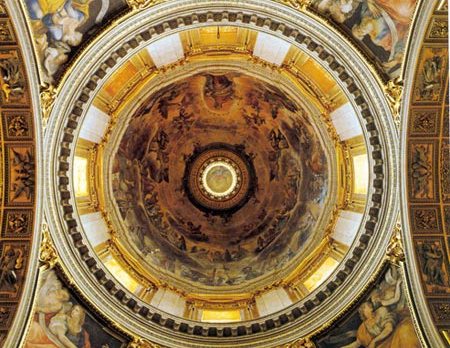Today’s Feast is now known as the Dedication of St. Mary Major (Santa Maria Maggiore)—celebrating one of only four major basilicas of the Roman Catholic Church and the largest (and possibly first) church dedicated to Mary in Rome.
Every year on August 5, white rose petals are dropped into the sanctuary from an opening in the coffered ceiling of Saint Mary Major to commemorate its legendary origin in the fourth century. As the story goes, during the night of August 4-5, 352 (or 358, in some accounts) the Mother of God appeared simultaneously in the dreams of Pope Liberius and of a wealthy, Roman named Giovanni Patrizio, who with his wife, had decided to leave everything they had to the Church. The Blessed Mother instructed them to build a church where her children could go to their Mother with their needs and prayers. Snow fall (in Rome’s sweltering August heat!) the following morning would indicate the site of the new church. Early in the morning of August 5, Pope Liberius was informed that snow had fallen on Esquiline Hill, including on land owned by Patrizio. A famous painting by Masolino depicts the Pope using a stick to delineate in the snow the outer foundation of what would become St. Mary Major.
The earliest name for the church was the Liberian Basilica, after Pope Liberius. It was also called Santa Maria della Neve (St. Mary of the Snow) and Santa Maria Del Presepe (St. Mary of the Crib) after 4 or 5 planks of wood, said to have come from Jesus’ crib, were given to St. Mary Major. They can still be venerated there.
During his pontificate, Pope Sixtus III (432-440) saw to a major renovation of the basilica and dedicated it to the Mother of God, following the declaration of Mary as Theotokos at the Council of Ephesus (431).
The basilica is home to 1600 years of some of the most exquisite art ever created, beginning with an icon of Mary—said to be painted by St. Luke—known as “Salus Populi Romani” (the salvation [or the “health”] of the Roman people). On the morning after his election, Pope Francis went to St. Mary Major to pray before this icon of the Madonna. It is also the site of many miracles and events of great significance in the life of the Church. For example, St. Ignatius Loyola celebrated his first Mass in St. Mary Major one Christmas night. On another Christmas Eve, the Blessed Mother placed the Infant Jesus into the arms of St. Cajetan of Thiene.
Francis has since celebrated Mass at St. Mary Major and will return to celebrate Mass on August 15, the Solemnity of the Assumption of Mary, as popes have done for centuries. I’ve always counted my family blessed because of the coincidence of birthdates with key events associated with St. Mary Major. Our youngest son was born on August 5; my husband’s birthday and our wedding anniversary fall on August 15. Our oldest son was born on October 7—the Feast of Our Lady of the Rosary. What is the connection between this Marian feast day and the Basilica of St. Mary Major?
Historian Robert McMullen describes the events of October 7, 1571 this way:
Of course, the Pope had no way of knowing that the battle was taking place that day. Meetings with certain cardinals kept the Holy Father at St. Mary Major into the afternoon when he suddenly interrupted the meeting, exclaiming:
News of the victory would not reach Rome for several weeks afterwards. It was a “decisive victory,” and even though Muslims did not entirely give up their efforts to invade and conquer Christian Europe, they never posed as grave a threat as they did that day, in the Battle of Lepanto.
Many tourists visit St. Mary Major to view the magnificent mosaics, spectacular columns in marble and numerous paintings, but the Basilica is also the resting place of three popes, as well as St. Jerome and the great sculptor Gian Lorenzo Bernini.
For more information about the history and treasures of St. Mary Major, visit the Vatican’s website. And if you’re not already doing so, at this time of renewed persecution of Christians by Muslim jihadists, let us follow the lead of Pope Pius V, and pray the rosary daily for an end to the persecution of Christians, wherever it is occurring.
Susan Willsis Spiritual Editor of Aleteia’s English-language edition.

